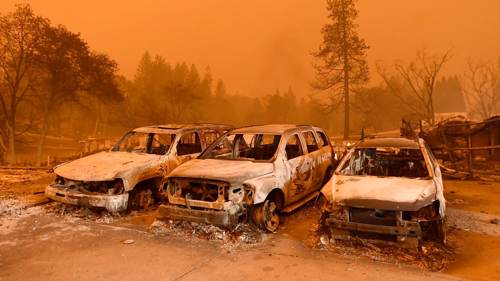The toll of destruction from the ongoing outbreak of California wildfires continues to rise, as the number of structures destroyed has risen again to 12,406, suggesting an increasing loss for insurance, reinsurance and ILS market interests and pointing to an industry loss at the high-end, or above, current estimates.
 Yesterday the total stood at roughly 10,800 structures destroyed, but the fire authorities investigations in particular of the Camp Fire in northern California’s Butte County, continues to result in increased properties lost.
Yesterday the total stood at roughly 10,800 structures destroyed, but the fire authorities investigations in particular of the Camp Fire in northern California’s Butte County, continues to result in increased properties lost.
In addition, the death toll from this wildfire looks set to rise significantly, as already the number of dead has leapt to more than 63, but with another 631 reported as missing largely from the town of Paradise, which was so badly impacted by the blaze.
The terrible impacts of the Camp fire are becoming clearer by the day as the investigation continues.
In terms of property damage, the Camp wildfire has resulted in 9700 single residential properties destroyed with another 155 damaged, 118 multiple residences destroyed, 290 commercial properties destroyed and 50 damaged, as well as 1,750 other minor structures destroyed, taking the total number of properties destroyed to 11,858.
The Woolsey fire, which burns in southern California’s Ventura County in the area around Malibu has now destroyed 546 structures, with another 157 damaged.
The Hill fire, also in Ventura, has still only destroyed 2 fires and damaged another 2.
In total, the 12,406 properties destroyed is now a higher total than the collective destruction from the Tubbs, Nuns, Atlas and Thomas wildfires from October and December 2017, which between them are estimated to have driven somewhere around $13 billion.
That suggests the current industry loss estimates for this outbreak will prove too low, given the number of properties known to be destroyed was much lower.
Hence the low-end of $4 billion of insurance and reinsurance industry losses from the recent wildfires seems far too low now, while the high-end estimate of $10 billion begins to seem a more reasonable approximation for the eventual loss.
As we’ve mentioned, the property damage is not the only vector of loss from these wildfires, as there will be other vectors of insurable loss (including automobiles, demand surge, business interruption and additional living-expense claims) to deal with.
Hence the loss could potentially be much more severe and the upper-end of $10 billion may even prove too low.
So the potential for the industry loss impact to insurance, reinsurance and insurance-linked securities (ILS) interests to be larger than the current estimated ranges is high and rising, as the amount of destruction becomes increasingly clear.
The wildfire liability for PG&E could remain uncertain for months though. Still the cause of the 2017 wildfires has not been officially identified, previous wildfires from 2015 have been attributed to electrical utility infrastructure faults which suggests the process to formally identify and apportion liability can even take years.
The PG&E catastrophe bond is not the only one threatened by the wildfires, as we explained yesterday. A cat bond sponsored by USAA is also considered one of the more at-risk aggregate structures and in addition private ILS or collateralised reinsurance losses are also expected.
The higher the industry loss rises the greater the threat to industry loss warranties (ILW) as well, with $10 billion perhaps set to prove to be an important trigger level in that marketplace.
On the retrocession side, losses are expected including to some collateralised retro covers and again as the industry loss rises the likely impacts to retrocessionaires is rising too.
The numbers of structures and properties affected by these wildfires will likely keep rising further and the fires are not yet contained (the Camp fire is 40% contained, the Woolsey 62% contained) and burns are ongoing. Hence there is the potential for the impacts to re/insurers to rise further over the coming days.
Also read:
PG&E’s wildfire cat bond marked down for loss, traded at distressed price.
USAA cat bond & private ILS also at risk of wildfire losses: Twelve Capital.
PG&E sued over Camp wildfire, putting Cal Phoenix Re cat bond in the frame.
Wildfire loss expectations rise, as structures destroyed passes 10,800.
Wildfires could cost insurers $5bn to $10bn: Credit Suisse analysts.
Wildfires to drive up to $6bn industry insured loss – Moody’s.
Wildfire losses to hit record in 2018, pricing needs to change: A.M. Best.
Stone Ridge & CATCo fund prices dented by California wildfire threat.
California wildfires destroy more property, but industry losses uncertain.
Cat bond price volatility & discounts expected from wildfires: Plenum.
California wildfire most destructive ever, multi-billion losses expected.
 View all of our Artemis Live video interviews and subscribe to our podcast.
View all of our Artemis Live video interviews and subscribe to our podcast.
All of our Artemis Live insurance-linked securities (ILS), catastrophe bonds and reinsurance video content and video interviews can be accessed online.
Our Artemis Live podcast can be subscribed to using the typical podcast services providers, including Apple, Google, Spotify and more.































